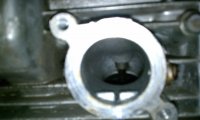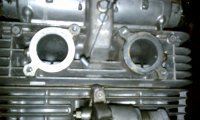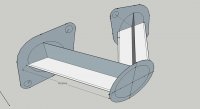GmanGS450
Active Member
Another project is on the horizon.
2-1 intake with a VM32 for a 1982 GS450T, trying to maximize power out from a not-so-powerful engine. Using the metal foundations of old rubber manifolds as the starting point.
The design is complete and the material are purchased. Now to cut, weld, test.
But I have a question about the intake port on the GS450, What are the flat tabs on the intake. Everything I've learned in schools tells me that removing these will create a faster gas flow into the pump that is an IC engine. Creating more power!!!! The increase intake length and size will give the gas flow greater velocity into the cylinder, so removing these shouldn't be a problem.
OR WILL IT?
Do these create a some kind of mixture in the intake port? Are these totally necessary? Keeping in mind that I am not using a stock carb and will have the chance to tune the singe VM round Slide better than two cv's. Is this an attempt to get a better burn of fuel to reduce emissions back in the day? Reduce the HP to meet US requirements?
I have alot of questions so if someone could please help me out, it would be greatly appreciated.
Attached are pictures of what I'm talking about.
2-1 intake with a VM32 for a 1982 GS450T, trying to maximize power out from a not-so-powerful engine. Using the metal foundations of old rubber manifolds as the starting point.
The design is complete and the material are purchased. Now to cut, weld, test.
But I have a question about the intake port on the GS450, What are the flat tabs on the intake. Everything I've learned in schools tells me that removing these will create a faster gas flow into the pump that is an IC engine. Creating more power!!!! The increase intake length and size will give the gas flow greater velocity into the cylinder, so removing these shouldn't be a problem.
OR WILL IT?
Do these create a some kind of mixture in the intake port? Are these totally necessary? Keeping in mind that I am not using a stock carb and will have the chance to tune the singe VM round Slide better than two cv's. Is this an attempt to get a better burn of fuel to reduce emissions back in the day? Reduce the HP to meet US requirements?
I have alot of questions so if someone could please help me out, it would be greatly appreciated.
Attached are pictures of what I'm talking about.







